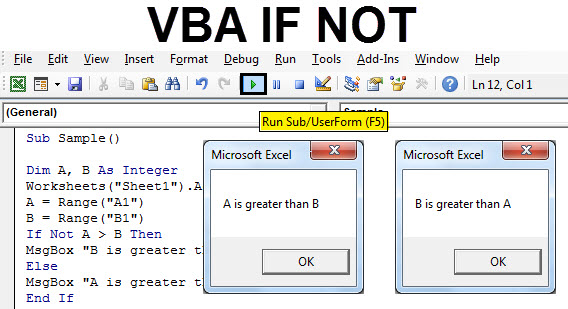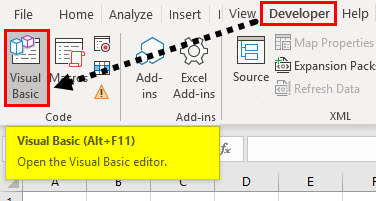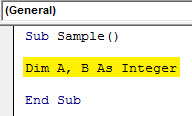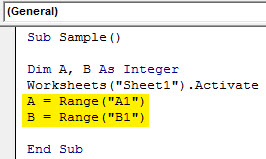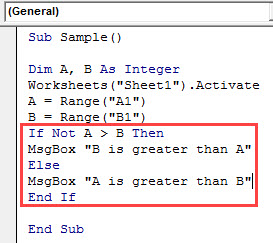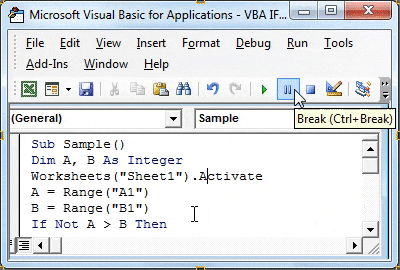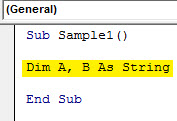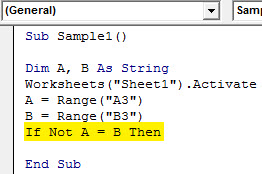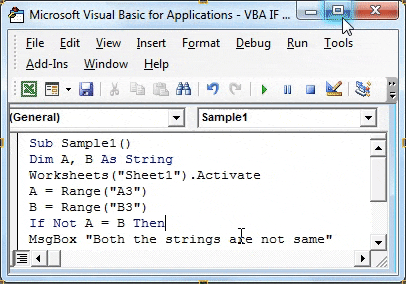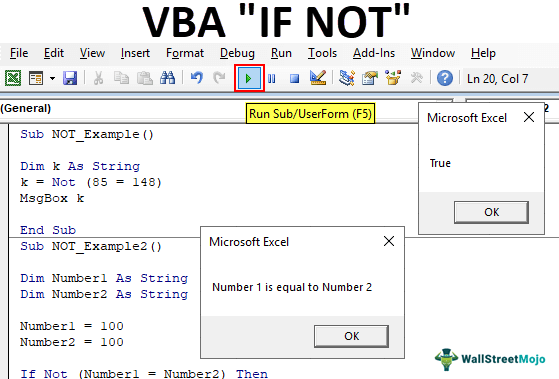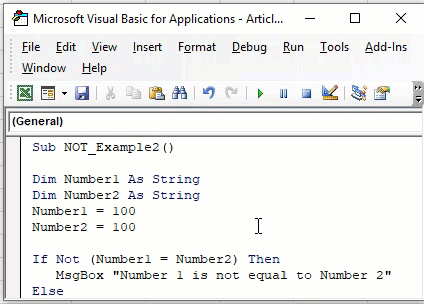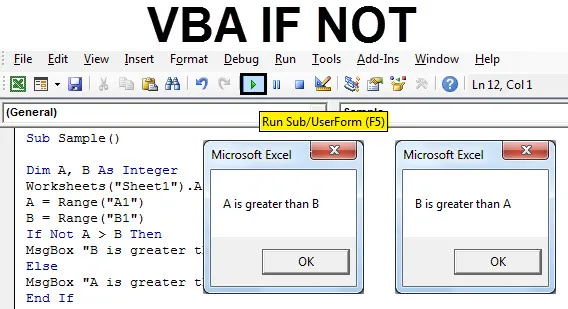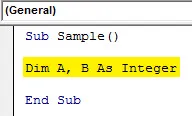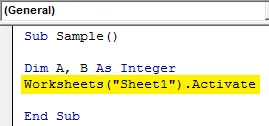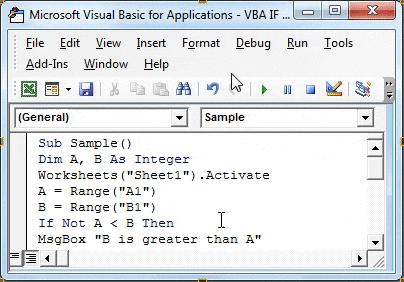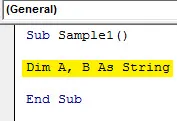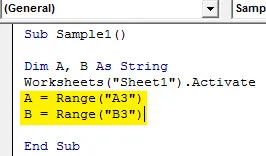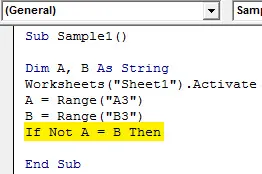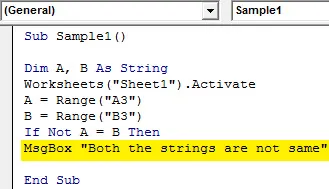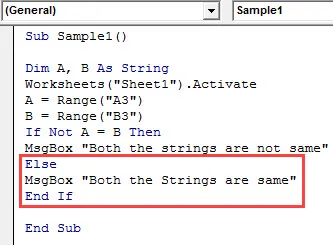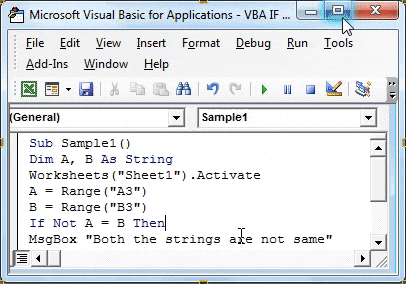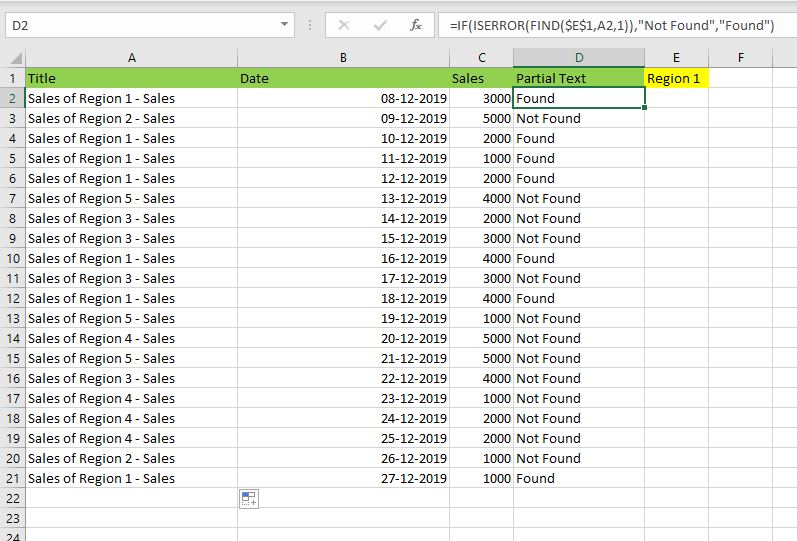VBA IF Not
In any programming language, we have logical operators AND OR and NOT. Every operator has a specific function to do. AND combines two or more statements and return values true if every one of the statements is true where is in OR operator if any one of the statements is true the value is true. The NOT operator is a different thing. NOT operator negates the given statement. We use these logical operators with IF statements in our day to day data analysis. If we use IF NOT statement in VBA consider this as an inverse function.
We have discussed above that we use the logical operators with if statements. In this article, we will use NOT operator with the if statement. I said earlier that IF NOT statement in VBA is also considered as an inverse function. Why is that because if the condition is true it returns false and if the condition is false it returns true. Have a look below,
IF A>B equals to IF NOT B>A
Both the if statements above are identical how? In the first statement if A is greater than B then the next statement is executed and in the next, if not statement means if B is not greater than A which in itself means A is greater than B.
The most simple way to understand IF NOT statement should be as follows:
If True Then If NOT false Then
Or we can say that
If False then IF NOT True then
Both the statements in Comparison 1 and Comparison 2 are identical to each other.
Let’s use IF NOT function in few examples which will make it more clearly for us.
Note: We need to keep in mind that in order to use VBA in excel we first have to enable our developer’s tab from the files tab and then from the options section.
How to Use Excel VBA IF Not?
We will learn how to use a VBA IF Not with few examples in excel.
You can download this VBA IF NOT Excel Template here – VBA IF NOT Excel Template
Example #1 – VBA IF Not
Follow the below steps to use IF NOT in Excel VBA.
For example, I have two values in sheet 1 in cell A1 and B1. Have a look at them below,
What I want to do is compare these two values which one is greater using IF NOT statement in VBA.
Step 1: Go to the developer’s tab and then click on Visual Basic to open the VB Editor.
Step 2: Insert a module from the insert tab in the VB Editor. Double click on the module we just inserted to open another window where we are going to write our code.
Step 3: Every VBA code starts with a sub-function as below,
Code:
Sub Sample() End Sub
Step 4: Declare two variables as integers which will store our values from cell A1 and B1.
Code:
Sub Sample() Dim A, B As Integer End Sub
Step 5: To assign values to these variables we need to activate the worksheet first by the following code.
Code:
Sub Sample() Dim A, B As Integer Worksheets("Sheet1").Activate End Sub
Step 6: Now we will assign these variables the values of A1 and B1.
Code:
Sub Sample() Dim A, B As Integer Worksheets("Sheet1").Activate A = Range("A1") B = Range("B1") End Sub
Step 7: Let us compare both the variables using IF NOT statement by the following code,
Code:
Sub Sample() Dim A, B As Integer Worksheets("Sheet1").Activate A = Range("A1") B = Range("B1") If Not A > B Then MsgBox "B is greater than A" Else MsgBox "A is greater than B" End If End Sub
Step 8: Run the above code from the run button in VBA or we can press the F5 button to do the same. We will get the following result.
Step 9: Let us inverse the values of A and B and again run the code to see the following result.
In the first execution, A was greater than B but we compared IF NOT A>B, Initially, the condition was true so it displayed the result for False statement i.e. A is greater than B and vice versa for execution second.
Example #2 – VBA IF Not
In the first example we compared integers, let us compare strings in this example with IF NOT statement in VBA. In the same sheet1, we have two strings in cell A3 and B3 as follows,
Let us compare both the strings using IF NOT Statement.
Step 1: To open VB Editor first click on Developer’s Tab and then click on Visual Basic.
Step 2: In the same module, we inserted above double click on it to start writing the second code.
Step 3: Declare a sub-function below the code we wrote first.
Code:
Sub Sample1() End Sub
Step 4: Declare two variables as a string that will store our values from cell A3 and B3.
Code:
Sub Sample1() Dim A, B As String End Sub
Step 5: To assign values to these variables we need to activate the worksheet first by the following code to use its properties.
Code:
Sub Sample1() Dim A, B As String Worksheets("Sheet1").Activate End Sub
Step 6: Now we will assign these variables the values of A3 and B3.
Code:
Sub Sample1() Dim A, B As String Worksheets("Sheet1").Activate A = Range("A3") B = Range("B3") End Sub
Step 7: Let us compare both the variables using IF NOT statement by the starting the if statement as follows,
Code:
Sub Sample1() Dim A, B As String Worksheets("Sheet1").Activate A = Range("A3") B = Range("B3") If Not A = B Then End Sub
Step 8: If A = B condition is true then the above statement will negate it and return the value as false.
Code:
Sub Sample1() Dim A, B As String Worksheets("Sheet1").Activate A = Range("A3") B = Range("B3") If Not A = B Then MsgBox "Both the strings are not same" End Sub
Step 9: If both the strings are same i.e. if the result is returned as true display the following message,
Code:
Sub Sample1() Dim A, B As String Worksheets("Sheet1").Activate A = Range("A3") B = Range("B3") If Not A = B Then MsgBox "Both the strings are not same" Else MsgBox "Both the Strings are same" End If End Sub
Step 10: Now let us run the above code by pressing the F5 button or from the run button given. Once we run the code we get the following result.
Step 11: Now let us make both the stings in A3 and B3 cell same to see the different result when we run the same code.
In the first execution A was not similar to B but we compared IF NOT A=B, Initially the condition was true so it displayed the result for false statement i.e. both the strings are not same and when both of the strings were same we get the different message as both the strings are same.
Things to Remember
- IF NOT is a comparison statement.
- IF NOT negates the value of the condition i.e. if a condition is true it returns false and vice versa.
- IF NOT statement is basically an inverse function.
Recommended Articles
This has been a guide to VBA If Not. Here we have discussed how to use Excel VBA If Not along with practical examples and downloadable excel template. You can also go through our other suggested articles –
- VBA Active Cell
- VBA RGB
- VBA Transpose
- VBA Not
Logical functions are useful for calculations that require multiple conditions or criteria to test. In our earlier articles, we have seen “VBA IF,” “VBA OR,” and “VBA AND” conditions. This article will discuss the “VBA IF NOT” function. Before introducing VBA IF NOT function, let me show you about VBA NOT functionThe VBA NOT function in MS Office Excel VBA is a built-in logical function. If a condition is FALSE, it yields TRUE; otherwise, it returns FALSE. It works as an inverse function.read more first.
Table of contents
- IF NOT in VBA
- What is NOT Function in VBA?
- Examples of NOT & IF Function in VBA?
- Example #1
- Example #2
- NOT with IF Condition:
- Recommended Articles
What is NOT Function in VBA?
The “NOT” function is one of our logical functions with Excel and VBA. All the logical functions require logical tests to perform and return TRUE if the logical test is correct. If the logical test is incorrect, it will return FALSE.
But “VBA NOT” is the opposite of the other logical function. So, we would say this is the inverse function of logical functions.
The “VBA NOT” function returns “FALSE” if the logical test is correct. If the logical test is incorrect, it will return “TRUE.” Now, look at the syntax of the “VBA NOT” function.
NOT(Logical Test)
It is very simple. First, we need to provide a logical test. Then, the NOT function evaluates the test and returns the result.
Examples of NOT & IF Function in VBA?
Below are the examples of using the IF and NOT function in excelNOT Excel function is a logical function in Excel that is also known as a negation function and it negates the value returned by a function or the value returned by another logical function.read more VBA.
You can download this VBA IF NOT Excel Template here – VBA IF NOT Excel Template
Example #1
Take a look at the below code for an example.
Code:
Sub NOT_Example() Dim k As String k = Not (100 = 100) MsgBox k End Sub
In the above code, we have declared the variable as a string.
Dim k As String
Then, for this variable, we have assigned the NOT function with the logical test as 100 = 100.
k = Not (100 = 100)
Then, we have written the code to show the result in the VBA message boxVBA MsgBox function is an output function which displays the generalized message provided by the developer. This statement has no arguments and the personalized messages in this function are written under the double quotes while for the values the variable reference is provided.read more. MsgBox k
Now, we will execute the code and see the result.
We got the result as “FALSE.”
Now, look back at the logical testA logical test in Excel results in an analytical output, either true or false. The equals to operator, “=,” is the most commonly used logical test.read more. We have provided the logical test as 100 = 100, which is generally TRUE; since we had given the NOT function, we got the result as FALSE. As we said in the beginning, it gives inverse results compared to other logical functions. Since 100 equals 100, it has returned the result as FALSE.
Example #2
Now, we will look at one more example with different numbers.
Code:
Sub NOT_Example() Dim k As String k = Not (85 = 148) MsgBox k End Sub
The code is the same. The only thing we have changed here is We have changed the logical test from 100 = 100 to 85 = 148.
Now, we will run the code and see what the result is.
This time we got the result as TRUE. Now, examine the logical test.
k = Not (85 = 148)
We all know 85 is not equal to the number 148. Since it is not equal, the NOT function has returned the result as TRUE.
NOT with IF Condition:
In Excel or VBA, logical conditions are incomplete without the combination IF condition. Using the IF condition in excelIF function in Excel evaluates whether a given condition is met and returns a value depending on whether the result is “true” or “false”. It is a conditional function of Excel, which returns the result based on the fulfillment or non-fulfillment of the given criteria.
read more we can do many more things beyond default TRUE or FALSE. For example, we got FALSE and TRUE default results in the above examples. Instead, we can modify the result in our own words.
Look at the below code.
Code:
Sub NOT_Example2() Dim Number1 As String Dim Number2 As String Number1 = 100 Number2 = 100 If Not (Number1 = Number2) Then MsgBox "Number 1 is not equal to Number 2" Else MsgBox "Number 1 is equal to Number 2" End If End Sub
We have declared two variables.
Dim Number1 As String & Dim Number2 As String
For these two variables, we have assigned the numbers 100 and 100, respectively.
Number1 = 100 & Number2 = 100
Then, we have attached the IF condition to alter the default TRUE or FALSE for the NOT function. If the result of the NOT function is TRUE, then my result will be as follows.
MsgBox “Number 1 is not equal to Number 2.”
If the NOT function result is FALSE, my result is as follows.
MsgBox “Number 1 is equal to Number 2.”
Now, we will run the code and see what happens.
We got the result as “Number 1 is equal to Number 2”, so the NOT function has returned the FALSE result to the IF condition. So, the IF condition returned this result.
Like this, we can use the IF condition to do the inverse test.
Recommended Articles
This article has been a guide to VBA IF NOT. Here, we discuss using the IF and NOT function in Excel VBA, examples, and downloadable Excel templates. Below are some useful articles related to VBA: –
- VBA Replace String
- VBA If Else Statement
- VBA AND Function
- IF OR in VBA
Sub Excel_ISTEXT_Function()
Dim ws As Worksheet
Set ws = Worksheets(«ISTEXT»)
ws.Range(«C5») = Application.WorksheetFunction.IsText(ws.Range(«B5»))
ws.Range(«C6») = Application.WorksheetFunction.IsText(ws.Range(«B6»))
ws.Range(«C7») = Application.WorksheetFunction.IsText(ws.Range(«B7»))
ws.Range(«C8») = Application.WorksheetFunction.IsText(ws.Range(«B8»))
ws.Range(«C9») = Application.WorksheetFunction.IsText(ws.Range(«B9»))
End Sub
OBJECTS
Worksheets: The Worksheets object represents all of the worksheets in a workbook, excluding chart sheets.
Range: The Range object is a representation of a single cell or a range of cells in a worksheet.
PREREQUISITES
Worksheet Name: Have a worksheet named ISTEXT.
ADJUSTABLE PARAMETERS
Output Range: Select the output range by changing the Range references («C5») through to («C9») in the VBA code to any cell in worksheet that doesn’t conflict with the formula.
На чтение 19 мин. Просмотров 24.3k.

Пьер Корнель
Угадай, если сможешь, и выбери, если посмеешь
Содержание
- Краткое руководство по VBA If Statement
- Что такое IF и зачем оно тебе?
- Тестовые данные
- Формат операторов VBA If Then
- Простой пример If Then
- Условия IF
- Использование If ElseIf
- Использование If Else
- Используя If And/If Or
- Функция IIF
- Использование Select Case
- Попробуйте это упражнение
Краткое руководство по VBA If Statement
| Описание | Формат | Пример |
| If Then | If [условие верно] Then [действие] End If |
If score = 100 Then Debug.Print «Отлично» End If |
| If Else | If [условие верно] Then [действие] Else [действие] End If |
If score = 100 Then Debug.Print «Отлично» Else Debug.Print «Попробуй снова» End If |
| If ElseIf | If [1 условие верно] Then [действие] ElseIf [2 условие верно] Then [действие] End If |
If score = 100 Then Debug.Print «Отлично» ElseIf score > 50 Then Debug.Print «Пройдено» ElseIf score <= 50 Then Debug.Print «Попробуй снова» End If |
| Else и ElseIf (Else должно идти после ElseIf’s) |
If [1 условие верно] Then [действие] ElseIf [2 условие верно] Then [действие] Else [действие] End If |
If score = 100 Then Debug.Print «Отлично» ElseIf score > 50 Then Debug.Print «Пройдено» ElseIf score > 30 Then Debug.Print «Попробуй снова» Else Debug.Print «Ой» End If |
| If без Endif (Только одна строка) |
If [условие верно] Then [действие] |
If value <= 0 Then value = 0 |
В следующем коде показан простой пример использования
оператора VBA If
If Sheet1.Range("A1").Value > 5 Then
Debug.Print "Значение больше 5."
ElseIf Sheet1.Range("A1").Value < 5 Then
Debug.Print "Значение меньше 5."
Else
Debug.Print "Значение равно 5."
End If
Что такое IF и зачем оно тебе?
Оператор VBA If используется, чтобы позволить вашему коду
делать выбор, когда он выполняется.
Вам часто захочется сделать выбор на основе данных, которые
читает ваш макрос.
Например, вы можете захотеть читать только тех учеников, у
которых оценки выше 70. Когда вы читаете каждого учащегося, вы можете
использовать инструкцию If для проверки отметок каждого учащегося.
Важным словом в последнем предложении является проверка. Оператор
If используется для проверки значения, а затем для выполнения задачи на основе
результатов этой проверки.
Тестовые данные
Мы собираемся использовать следующие тестовые данные для
примеров кода в этом посте.
Формат операторов VBA If Then
Формат оператора If Then следующий
За ключевым словом If следуют условие и ключевое слово Then
Каждый раз, когда вы используете оператор If Then, вы должны использовать соответствующий оператор End If.
Когда условие оценивается как истинное, обрабатываются все
строки между If Then и End If.
If [условие верно] Then
[строки кода]
[строки кода]
[строки кода]
End If
Чтобы сделать ваш код более читабельным, рекомендуется
делать отступы между операторами If Then и End If.
Отступ между If и End If
Отступ означает просто переместить строку кода на одну вкладку вправо. Правило большого пальца состоит в том, чтобы сделать отступ между начальным и конечным операторами, такими как:
Sub … End Sub
If Then … End If
If Then… ElseIf … Else … Endif
For … Next
Do While … Loop
Select Case … End Case
Для отступа в коде вы можете выделить строки для отступа и нажать клавишу Tab. Нажатие клавиш Shift + Tab сделает отступ кода, т.е. переместит его на одну вкладку влево.
Вы также можете использовать значки на панели инструментов Visual Basic для отступа кода.
Если вы посмотрите на примеры кода на этом сайте, вы увидите, что код имеет отступ.
Простой пример If Then
Следующий код выводит имена всех студентов с баллами более 50.
Sub ChitatOcenki()
Dim i As Long
' Пройдите столбцы отметок
For i = 2 To 11
' Проверьте, больше ли баллов,чем 50
If Sheet1.Range("C" & i).Value > 50 Then
' Напечатайте имя студента в «Immediate Window» (Ctrl + G)
Debug.Print Sheet1.Range("A" & i).Value & " " & Sheet1.Range("B" & i).Value
End If
Next
End Sub
Результаты:
- Василий Кочин
- Максим Бородин
- Дмитрий Маренин
- Олеся Клюева
- Евгений Яшин
Поэкспериментируйте с этим примером и проверьте значение или знак > и посмотрите, как изменились результаты.
Условия IF
Часть кода между ключевыми словами If и Then называется условием. Условие — это утверждение, которое оценивается как истинное или ложное. Они в основном используются с операторами Loops и If. При создании условия вы используете такие знаки, как «>, <, <>,> =, <=, =».
Ниже приведены примеры условий:
| Условие | Это верно, когда |
| x < 5 | x меньше,чем 5 |
| x <= 5 | x меньше, либо равен 5 |
| x > 5 | x больше, чем 5 |
| x >= 5 | x больше, либо равен 5 |
| x = 5 | x равен 5 |
| x <> 5 | x не равен 5 |
| x > 5 And x < 10 | x больше, чем 5 И x меньше, чем 10 |
| x = 2 Or x >10 | x равен 2 ИЛИ x больше,чем 10 |
| Range(«A1») = «Иван» | Ячейка A1 содержит текст «Иван» |
| Range(«A1») <> «Иван» | Ячейка A1 не содержит текст «Иван» |
Вы могли заметить x = 5, как условие. Не стоит путать с х = 5, при использовании в качестве назначения.
Когда в условии используется «=», это означает, что «левая сторона равна правой стороне».
В следующей таблице показано, как знак равенства используется
в условиях и присваиваниях.
| Использование «=» | Тип | Значение |
| Loop Until x = 5 | Условие | Равен ли x пяти |
| Do While x = 5 | Условие | Равен ли x пяти |
| If x = 5 Then | Условие | Равен ли x пяти |
| For x = 1 To 5 | Присваивание | Установите значение х = 1, потом = 2 и т.д. |
| x = 5 | Присваивание | Установите х до 5 |
| b = 6 = 5 | Присваивание и условие |
Присвойте b результату условия 6 = 5 |
| x = MyFunc(5,6) | Присваивание | Присвойте х значение, возвращаемое функцией |
Последняя запись в приведенной выше таблице показывает
оператор с двумя равными. Первый знак равенства — это присвоение, а любые
последующие знаки равенства — это условия.
Поначалу это может показаться странным, но подумайте об этом
так. Любое утверждение, начинающееся с переменной и равно, имеет следующий
формат
[переменная] [=] [оценить эту часть]
Поэтому все, что находится справа от знака равенства, оценивается и результат помещается в переменную. Посмотрите на последние три строки таблицы, как:
[x] [=] [5]
[b] [=] [6 = 5]
[x] [=] [MyFunc (5,6)]
Использование If ElseIf
Инструкция ElseIf позволяет вам выбирать из нескольких вариантов. В следующем примере мы печатаем баллы, которые находятся в диапазоне.
Sub IspElseIf()
If Marks >= 85 Then
Debug.Print "Высший балл"
ElseIf Marks >= 75 Then
Debug.Print "Отлично"
End If
End Sub
Важно понимать, что порядок важен. Условие If проверяется
первым.
Если это правда, то печатается «Высший балл», и оператор If заканчивается.
Если оно ложно, то код переходит к следующему ElseIf и
проверяет его состояние.
Давайте поменяемся местами If и ElseIf из последнего
примера. Код теперь выглядит так
Sub IspElseIfNeverno()
' Этот код неверен, так как ElseIf никогда не будет верным
If Marks >= 75 Then
Debug.Print "Отлично"
ElseIf Marks >= 85 Then
' код никогда не достигнет здесь
Debug.Print "Высший балл"
End If
End Sub
В этом случае мы сначала проверяем значение более 75. Мы никогда не будем печатать «Высший балл», потому что, если значение больше 85, это вызовет первый оператор if.
Чтобы избежать подобных проблем, мы должны использовать два
условия. Они помогают точно указать, что вы ищете, чтобы избежать путаницы.
Пример ниже показывает, как их использовать. Мы рассмотрим более многочисленные
условия в разделе ниже.
If marks >= 75 And marks < 85 Then
Debug.Print "Отлично"
ElseIf marks >= 85 And marks <= 100 Then
Debug.Print "Высший балл"
End If
Давайте расширим оригинальный код. Вы можете использовать столько операторов ElseIf, сколько захотите. Мы добавим еще несколько, чтобы учесть все наши классификации баллов.
Использование If Else
Утверждение Else используется, как ловушка для всех. Это в основном означает «если бы не было условий» или «все остальное». В предыдущем примере кода мы не включили оператор печати для метки сбоя. Мы можем добавить это, используя Else.
Sub IspElse()
If Marks >= 85 Then
Debug.Print "Высший балл"
ElseIf Marks >= 75 Then
Debug.Print "Отлично"
ElseIf Marks >= 55 Then
Debug.Print "Хорошо"
ElseIf Marks >= 40 Then
Debug.Print "Удовлетворительно"
Else
' Для всех других оценок
Debug.Print "Незачет"
End If
End Sub
Так что, если это не один из других типов, то это провал.
Давайте напишем некоторый код с помощью наших примеров
данных и распечатаем студента и его классификацию.
Sub DobClass()
' получить последнюю строку
Dim startRow As Long, lastRow As Long
startRow = 2
lastRow = Sheet1.Cells(Sheet1.Rows.Count, 1).End(xlUp).Row
Dim i As Long, Marks As Long
Dim sClass As String
' Пройдите столбцы отметок
For i = startRow To lastRow
Marks = Sheet1.Range("C" & i).Value
' Проверьте отметки и классифицируйте соответственно
If Marks >= 85 Then
sClass = "Высший балл"
ElseIf Marks >= 75 Then
sClass = "Отлично"
ElseIf Marks >= 55 Then
sClass = "Хорошо"
ElseIf Marks >= 40 Then
sClass = "Удовлетворительно"
Else
' Для всех других оценок
sClass = "Незачет"
End If
' Запишите класс в столбец E
Sheet1.Range("E" & i).Value = sClass
Next
End Sub
Результаты выглядят так: в столбце E — классификация баллов
Используя If And/If Or
В выражении If может быть несколько условий. Ключевые слова VBA And и Or позволяют использовать несколько условий.
Эти слова работают так же, как вы используете их на
английском языке.
Давайте снова посмотрим на наши примеры данных. Теперь мы
хотим напечатать всех студентов, которые набрали от 50 до 80 баллов.
Мы используем Аnd, чтобы добавить дополнительное условие. Код гласит: если оценка больше или равна 50 и меньше 75, напечатайте имя студента.
Sub ProverkaStrokiOcenok()
Dim i As Long, marks As Long
For i = 2 To 11
' Хранить оценки для текущего студента
marks = Sheet1.Range("C" & i).Value
' Проверьте, если отметки больше 50 и меньше 75
If marks >= 50 And marks < 80 Then
' Напечатайте имя и фамилию в Immediate window (Ctrl+G)
Debug.Print Sheet1.Range("A" & i).Value & Sheet1.Range("B" & i).Value
End If
Next
End Sub
Вывести имя и фамилию в результаты:
- Дмитрий Маренин
- Олеся Клюева
- Евгений Яшин
В нашем следующем примере мы хотим знать, кто из студентов сдавал историю или геометрию. Таким образом, в данном случае мы говорим, изучал ли студент «История» ИЛИ изучал ли он «Геометрия» (Ctrl+G).
Sub ChitatObektOcenki()
Dim i As Long, marks As Long
' Пройдите столбцы отметок
For i = 2 To 11
marks = Sheet1.Range("D" & i).Value
' Проверьте, если отметки больше 50 и меньше 80
If marks = "История" Or marks = "Геометрия" Then
' Напечатайте имя и фамилию в Immediate window (Ctrl+G)
Debug.Print Sheet1.Range("A" & i).Value & " " & Sheet1.Range("B" & i).Value
End If
Next
End Sub
Результаты:
- Василий Кочин
- Александр Грохотов
- Дмитрий Маренин
- Николай Куликов
- Олеся Клюева
- Наталия Теплых
- Дмитрий Андреев
Использование нескольких таких условий часто является
источником ошибок. Эмпирическое правило, которое нужно помнить, должно быть
максимально простым.
Использование IF AND
And работает следующим образом:
| Условие 1 | Условие 2 | Результат |
| ИСТИНА | ИСТИНА | ИСТИНА |
| ИСТИНА | ЛОЖЬ | ЛОЖЬ |
| ЛОЖЬ | ИСТИНА | ЛОЖЬ |
| ЛОЖЬ | ЛОЖЬ | ЛОЖЬ |
Что вы заметите, так это то, что And верно только тогда, когда все условия выполняются.
Использование IF OR
Ключевое слово OR работает следующим образом
| Условие 1 | Условие 2 | Результат |
| ИСТИНА | ИСТИНА | ИСТИНА |
| ИСТИНА | ЛОЖЬ | ИСТИНА |
| ЛОЖЬ | ИСТИНА | ИСТИНА |
| ЛОЖЬ | ЛОЖЬ | ЛОЖЬ |
Что вы заметите, так это то, что OR ложно, только когда все условия ложны.
Смешивание And и Or может затруднить чтение кода и привести к ошибкам. Использование скобок может сделать условия более понятными.
Sub OrSAnd()
Dim subject As String, marks As Long
subject = "История"
marks = 5
If (subject = "Геометрия" Or subject = "История") And marks >= 6 Then
Debug.Print "ИСТИНА"
Else
Debug.Print "ЛОЖЬ"
End If
End Sub
Использование IF NOT
Также есть оператор NOT. Он возвращает противоположный результат условия.
| Условие | Результат |
| ИСТИНА | ЛОЖЬ |
| ЛОЖЬ | ИСТИНА |
Следующие две строки кода эквивалентны.
If marks < 40 Then If Not marks >= 40 Then
так же, как и
If True Then If Not False Then
и
If False Then If Not True Then
Помещение условия в круглые скобки облегчает чтение кода
If Not (marks >= 40) Then
Распространенное использование Not — при проверке, был ли установлен объект. Возьмите Worksheet для примера. Здесь мы объявляем рабочий лист.
Dim mySheet As Worksheet ' Некоторый код здесь
Мы хотим проверить действительность mySheet перед его использованием. Мы можем проверить, если это Nothing.
If mySheet Is Nothing Then
Нет способа проверить, является ли это чем-то, поскольку есть много разных способов, которым это может быть что-то. Поэтому мы используем NOT с Nothing.
If Not mySheet Is Nothing Then
Если вы находите это немного запутанным, вы можете использовать круглые скобки, как здесь
If Not (mySheet Is Nothing) Then
Функция IIF
VBA имеет функцию, аналогичную функции Excel If. В Excel вы часто используете функцию If следующим образом:
= ЕСЛИ (F2 =»»,»», F1 / F2)
Формат
= If (условие, действие, если ИСТИНА, действие, если ЛОЖЬ).
VBA имеет функцию IIf, которая работает так же. Давайте посмотрим на примере. В следующем коде мы используем IIf для проверки значения переменной val. Если значение больше 10, мы печатаем ИСТИНА, в противном случае мы печатаем ЛОЖЬ.
Sub ProveritVal()
Dim result As Boolean
Dim val As Long
' Печатает ИСТИНА
val = 11
result = IIf(val > 10, ИСТИНА, ЛОЖЬ)
Debug.Print result
' печатает ЛОЖЬ
val = 5
result = IIf(val > 10, ИСТИНА, ЛОЖЬ)
Debug.Print result
End Sub
В нашем следующем примере мы хотим распечатать «Удовлетворитеьно» или «Незачет» рядом с каждым студентом в зависимости от их баллов. В первом фрагменте кода мы будем использовать обычный оператор VBA If, чтобы сделать это.
Sub ProveritDiapazonOcenok()
Dim i As Long, marks As Long
For i = 2 To 11
' Хранить оценки для текущего студента
marks = Sheet1.Range("C" & i).Value
' Проверьте, прошел ли студент или нет
If marks >= 40 Then
' Запишите имена для столбца F
Sheet1.Range("E" & i) = "Удовлетворительно"
Else
Sheet1.Range("E" & i) = "Незачет"
End If
Next
End Sub
В следующем фрагменте кода мы будем использовать функцию IIf. Код здесь намного аккуратнее.
Sub ProveritDiapazonOcenok ()
Dim i As Long, marks As Long
For i = 2 To 11
' Хранить оценки для текущего студента
marks = Sheet1.Range("C" & i)
' Проверьте, прошел ли студент или нет
Sheet1.Range("E" & i).Value = IIf(marks >= 40,"Удовлетворительно","Незачет")
Next
End Sub
Функция IIf очень полезна для простых случаев, когда вы имеете дело с двумя возможными вариантами.
Использование Nested IIf
Вы также можете вкладывать IIf-операторы, как в Excel. Это означает использование результата одного IIf с другим. Давайте добавим еще один тип результата в наши предыдущие примеры. Теперь мы хотим напечатать «Отлично», «Удовлетворительно» или «Незачетт» для каждого студента.
Используя обычный VBA, мы сделали бы это так
Sub ProveritRezultatiTip2()
Dim i As Long, marks As Long
For i = 2 To 11
' Хранить оценки для текущего студента
marks = Sheet1.Range("C" & i).Value
If marks >= 75 Then
Sheet1.Range("E" & i).Value = "Отлично"
ElseIf marks >= 40 Then
' Запишите имена для столбца F
Sheet1.Range("E" & i).Value = "Удовлетворительно"
Else
Sheet1.Range("E" & i).Value = "Незачет"
End If
Next
End Sub
Используя вложенные IIfs, мы могли бы сделать это так
Sub IspNestedIIF()
Dim i As Long, marks As Long, result As String
For i = 2 To 11
marks = Sheet1.Range("C" & i).Value
result = IIf(marks >= 55,"Хорошо",IIf(marks >= 40,"Удовлетворительно","Незачет"))
Sheet1.Range("E" & i).Value = result
Next
End Sub
Использование вложенного IIf хорошо в простых случаях, подобных этому. Код прост для чтения и, следовательно, вряд ли вызовет ошибки.
Чего нужно остерегаться
Важно понимать, что функция IIf всегда оценивает как
Истинную, так и Ложную части выражения независимо от условия.
В следующем примере мы хотим разделить по баллам, когда он не равен нулю. Если он равен нулю, мы хотим вернуть ноль.
marks = 0 total = IIf(marks = 0, 0, 60 / marks)
Однако, когда отметки равны нулю, код выдаст ошибку «Делить на ноль». Это потому, что он оценивает как Истинные, так и Ложные утверждения. Здесь ложное утверждение, т.е. (60 / Marks), оценивается как ошибка, потому что отметки равны нулю.
Если мы используем нормальный оператор IF, он будет
запускать только соответствующую строку.
marks = 0
If marks = 0 Then
'Выполняет эту строку только когда отметки равны нулю
total = 0
Else
'Выполняет только эту строку, когда отметки не равны нулю
total = 60 / marks
End If
Это также означает, что если у вас есть функции для ИСТИНА и ЛОЖЬ, то обе будут выполнены. Таким образом, IIF будет запускать обе функции, даже если он использует только одно возвращаемое значение. Например:
' Обе функции будут выполняться каждый раз total = IIf(marks = 0, Func1, Func2)
IF против IIf
Так что лучше?
В этом случае вы можете видеть, что IIf короче для написания и аккуратнее. Однако если условия усложняются, вам лучше использовать обычное выражение If. Недостатком IIf является то, что он недостаточно известен, поэтому другие пользователи могут не понимать его так же, как и код, написанный с помощью обычного оператора if.
Кроме того, как мы обсуждали в последнем разделе, IIF всегда оценивает части ИСТИНА и ЛОЖЬ, поэтому, если вы имеете дело с большим количеством данных, оператор IF будет быстрее.
Мое эмпирическое правило заключается в том, чтобы
использовать IIf, когда
он будет прост для чтения и не требует вызовов функций. Для более сложных
случаев используйте обычный оператор If.
Использование Select Case
Оператор Select Case
— это альтернативный способ написания статистики If с большим количеством ElseIf. Этот тип операторов
вы найдете в большинстве популярных языков программирования, где он называется
оператором Switch. Например,
Java, C #, C ++ и Javascript
имеют оператор switch.
Формат
Select Case [переменная]
Case [условие 1]
Case [условие 2]
Case [условие n]
Case Else
End Select
Давайте возьмем наш пример DobClass сверху и перепишем его с помощью оператора Select Case.
Sub DobavitClass()
' получить последнюю строку
Dim startRow As Long, lastRow As Long
startRow = 2
lastRow = Sheet1.Cells(Sheet1.Rows.Count, 1).End(xlUp).Row
Dim i As Long, Marks As Long
Dim sClass As String
' Пройдите столбцы отметок
For i = startRow To lastRow
Marks = Sheet1.Range("C" & i).Value
' Проверьте отметки и классифицируйте соответственно
If Marks >= 85 Then
sClass = "Высший балл"
ElseIf Marks >= 75 Then
sClass = "Отлично"
ElseIf Marks >= 55 Then
sClass = "Хорошо"
ElseIf Marks >= 40 Then
sClass = "Удовлетворительно"
Else
' Для всех других оценок
sClass = "Незачет"
End If
' Запишите класс в столбец E
Sheet1.Range("E" & i).Value = sClass
Next
End Sub
Ниже приведен тот же код с использованием оператора Select Case. Главное, что вы заметите, это то, что мы используем “Case 85 to 100” rather than “marks >=85 And marks <=100”. , а не “marks >=85 And marks <=100”.
Sub DobavitClassSSelect()
' получить первую и последнюю строки
Dim firstRow As Long, lastRow As Long
firstRow = 2
lastRow = Cells(Cells.Rows.Count, 1).End(xlUp).Row
Dim i As Long, marks As Long
Dim sClass As String
' Пройдите столбцы отметок
For i = firstRow To lastRow
marks = Sheet1.Range("C" & i).Value
' Проверьте отметки и классифицируйте соответственно
Select Case marks
Case 85 To 100
sClass = "Высший балл"
Case 75 To 84
sClass = "Отлично"
Case 55 To 74
sClass = "Хорошо"
Case 40 To 54
sClass = "Удовлетворительно"
Case Else
' Для всех других оценок
sClass = "Незачет"
End Select
' Запишите класс в столбец E
Sheet1.Range("E" & i).Value = sClass
Next
End Sub
Использование Case Is
Вы можете переписать оператор select в том же формате, что и оригинальный ElseIf. Вы можете использовать Is с Case.
Select Case marks
Case Is >= 85
sClass = "Высший балл"
Case Is >= 75
sClass = "Отлично"
Case Is >= 55
sClass = "Хорошо"
Case Is >= 40
sClass = "Удовлетворительно"
Case Else
' Для всех других оценок
sClass = "Незачет"
End Select
Вы можете использовать Is для проверки нескольких значений.
В следующем коде мы проверяем, равны ли оценки 5, 7 или 9.
Sub TestNeskZnach()
Dim marks As Long
marks = 7
Select Case marks
Case Is = 5, 7, 9
Debug.Print True
Case Else
Debug.Print False
End Select
End Sub
Попробуйте это упражнение
В этой статье много рассказывали о выражении If. Хороший способ помочь вам понять — это попытаться написать код, используя темы, которые мы рассмотрели. В следующем упражнении используются тестовые данные из этой статьи. Ответ на упражнение ниже.
Мы будем использовать ячейку G1, чтобы написать имя
субъекта.
В колонках от H до L запишите всех студентов, которые имеют оценки по этому предмету. Мы хотим классифицировать их результат как успешный или неудачный. Оценка ниже 40 — неудача, оценка 40 или выше — Зачет.
Колонка H: Имя
Колонка I: Фамилия
Колонка J: Баллы
Колонка H: Предмет
Столбец I: Тип результата — Зачет или Незачет
Если ячейка G1 содержит «Геометрия», то ваш результат должен выглядеть следующим образом:
Ответ на упражнение
Следующий код показывает, как выполнить вышеупомянутое упражнение.
Примечание: есть много способов выполнить задачу, поэтому не расстраивайтесь, если ваш код отличается.
Sub ZapisatRezultat()
' Получить тему
Dim subject As String
subject = Sheet1.Range("G1").Value
If subject = "" Then
Exit Sub
End If
' Получить первый и последний ряд
Dim firstRow As Long, lastRow As Long
firstRow = 2
lastRow = Cells(Cells.Rows.Count, 1).End(xlUp).Row
' Очистить любой существующий вывод
Sheet1.Range("H:L").ClearContents
' Отслеживать выходной ряд
Dim outRow As Long
outRow = 1
Dim i As Long, marks As Long, rowSubject As String
' Прочитать данные
For i = firstRow To lastRow
marks = Sheet1.Range("C" & i).Value
rowSubject = Sheet1.Range("D" & i).Value
If rowSubject = subject Then
' Запишите данные студента, если предмет Геометрия
Sheet1.Range("A" & i & ":" & "D" & i).Copy
Sheet1.Range("H" & outRow).PasteSpecial xlPasteValues
' Запишите Зачет или Незачет
If marks < 40 Then
Sheet1.Range("L" & outRow).Value = "Незачет"
ElseIf marks >= 40 Then
Sheet1.Range("L" & outRow).Value = "Зачет"
End If
' Переместить вывод в следующую строку
outRow = outRow + 1
End If
Next i
End Sub
- VBA ЕСЛИ НЕ
VBA ЕСЛИ НЕ
На любом языке программирования у нас есть логические операторы И ИЛИ и НЕ. У каждого оператора есть определенная функция. AND объединяет два или более операторов и возвращает значения true, если каждое из утверждений истинно, где находится в операторе OR, если любое из утверждений истинно, значение истинно. Оператор НЕ — это другое. Оператор NOT отрицает данное утверждение. Мы используем эти логические операторы с операторами IF в нашем повседневном анализе данных. Если мы используем оператор IF NOT в VBA, рассмотрим это как обратную функцию.
Выше мы обсуждали, что мы используем логические операторы с операторами if. В этой статье мы будем использовать оператор NOT с оператором if. Ранее я говорил, что оператор IF NOT в VBA также рассматривается как обратная функция. Почему, потому что, если условие истинно, оно возвращает ложь, а если условие ложно, оно возвращает истину. Посмотрите ниже,
ЕСЛИ A> B равно IF НЕ B> A
Оба предложения if выше идентичны, как? В первом операторе, если A больше, чем B, выполняется следующий оператор, а в следующем, если не оператор, означает, что B не больше, чем A, что само по себе означает, что A больше, чем B.
Самый простой способ понять утверждение IF NOT должно быть следующим:
Если верно, то если не ложно, то
Или мы можем сказать, что
Если Ложь, тогда ЕСЛИ НЕ Верно
Оба утверждения в Сравнении 1 и Сравнении 2 идентичны друг другу.
Давайте использовать функцию IF NOT в нескольких примерах, которые сделают ее более понятной для нас.
Примечание : мы должны помнить, что для использования VBA в Excel мы должны сначала включить вкладку нашего разработчика на вкладке файлов, а затем в разделе параметров.
Как использовать Excel VBA, если нет?
Мы научимся использовать VBA IF Not с несколькими примерами в Excel.
Вы можете скачать этот VBA, если не шаблон Excel здесь — VBA, если не шаблон Excel
Пример № 1 — VBA, если нет
Выполните следующие шаги, чтобы использовать ЕСЛИ НЕ в Excel VBA.
Например, у меня есть два значения на листе 1 в ячейках A1 и B1. Посмотрите на них ниже,
То, что я хочу сделать, это сравнить эти два значения, которое больше, используя оператор IF NOT в VBA.
Шаг 1: Перейдите на вкладку разработчика и нажмите Visual Basic, чтобы открыть редактор VB.
Шаг 2: Вставьте модуль из вкладки вставки в VB Editor. Дважды щелкните по модулю, который мы только что вставили, чтобы открыть другое окно, в которое мы собираемся написать наш код.
Шаг 3: Каждый код VBA начинается с подфункции, как показано ниже,
Код:
Sub Sample () End Sub
Шаг 4: Объявите две переменные как целые числа, которые будут хранить наши значения из ячеек A1 и B1.
Код:
Sub Sample () Dim A, B As Integer End Sub
Шаг 5: Чтобы присвоить значения этим переменным, нам нужно сначала активировать лист с помощью следующего кода.
Код:
Sub Sample () Dim A, B As Integer Worksheets ("Sheet1"). Активировать End Sub
Шаг 6: Теперь мы присвоим этим переменным значения A1 и B1.
Код:
Sub Sample () Dim A, B As Integer Worksheets ("Sheet1"). Активировать A = Range ("A1") B = Range ("B1") End Sub
Шаг 7: Давайте сравним обе переменные, используя оператор IF NOT с помощью следующего кода:
Код:
Sub Sample () Dim A, B As Integer Worksheets ("Sheet1"). Активируйте A = Range ("A1") B = Range ("B1") Если не A> B, то MsgBox "B больше, чем A" Иначе MsgBox «A больше, чем B» End If End Sub
Шаг 8: Запустите приведенный выше код с кнопки запуска в VBA, или мы можем нажать кнопку F5, чтобы сделать то же самое. Мы получим следующий результат.
Шаг 9: Давайте инвертируем значения A и B и снова запустим код, чтобы увидеть следующий результат.
В первом выполнении A было больше, чем B, но мы сравнивали IF NOT A> B, изначально условие было истинным, поэтому оно отображало результат для оператора False, т. Е. A больше, чем B, и наоборот для второго выполнения.
Пример № 2 — VBA, если нет
В первом примере мы сравнили целые числа, давайте сравним строки в этом примере с оператором IF NOT в VBA. В том же листе 1 у нас есть две строки в ячейках A3 и B3 следующим образом:
Давайте сравним обе строки, используя оператор IF NOT.
Шаг 1: Чтобы открыть VB Editor, сначала нажмите вкладку разработчика, а затем нажмите Visual Basic.
Шаг 2: В тот же модуль, который мы вставили выше, дважды щелкните по нему, чтобы начать писать второй код.
Шаг 3: Объявите подфункцию под кодом, который мы написали первым.
Код:
Sub Sample1 () End Sub
Шаг 4: Объявите две переменные в виде строки, в которой будут храниться наши значения из ячеек A3 и B3.
Код:
Sub Sample1 () Dim A, B As String End Sub
Шаг 5: Чтобы присвоить значения этим переменным, нам нужно сначала активировать лист с помощью следующего кода, чтобы использовать его свойства.
Код:
Sub Sample1 () Dim A, B As String Worksheets ("Sheet1"). Активировать End Sub
Шаг 6: Теперь мы присвоим этим переменным значения A3 и B3.
Код:
Sub Sample1 () Dim A, B As String Worksheet ("Sheet1"). Активировать A = диапазон ("A3") B = диапазон ("B3") End Sub
Шаг 7: Давайте сравним обе переменные, используя оператор IF NOT, начав оператор if следующим образом:
Код:
Sub Sample1 () Dim A, B As String Worksheets ("Sheet1"). Активируйте A = Range ("A3") B = Range ("B3"), если не A = B, тогда End Sub
Шаг 8: Если условие A = B является истинным, то приведенное выше утверждение отрицает его и возвращает значение как ложное.
Код:
Sub Sample1 () Dim A, B As String Worksheets ("Sheet1"). Активируйте A = Range ("A3") B = Range ("B3") Если не A = B, то MsgBox "Обе строки не совпадают" Конец Sub
Шаг 9: Если обе строки одинаковы, т. Е. Если результат возвращен как true, отобразите следующее сообщение,
Код:
Sub Sample1 () Dim A, B As String Worksheets ("Sheet1"). Активируйте A = Range ("A3") B = Range ("B3") Если не A = B, то MsgBox "Обе строки не одинаковы" Иначе MsgBox "Обе строки одинаковы" End If End Sub
Шаг 10: Теперь давайте запустим приведенный выше код, нажав кнопку F5 или указанную кнопку запуска. Запустив код, мы получим следующий результат.
Шаг 11: Теперь давайте сделаем одинаковые строки в ячейках A3 и B3, чтобы увидеть разные результаты при выполнении одного и того же кода.
В первом исполнении A не было похоже на B, но мы сравнивали IF NOT A = B, изначально условие было истинным, поэтому оно отображало результат для ложного утверждения, т. Е. Обе строки не совпадают, и когда обе строки были одинаковыми, мы получаем разные сообщения, так как обе строки одинаковы.
То, что нужно запомнить
- ЕСЛИ НЕ является сравнительным утверждением.
- Если NOT отрицает значение условия, то есть если условие истинно, оно возвращает ложь, и наоборот.
- Если оператор NOT является в основном обратной функцией.
Рекомендуемые статьи
Это было руководство для VBA, если нет. Здесь мы обсудили, как использовать Excel VBA If Not вместе с практическими примерами и загружаемым шаблоном Excel. Вы также можете просмотреть наши другие предлагаемые статьи —
- Работа с VBA Active Cell
- Удаление строки в VBA
- Как использовать Excel VBA Transpose?
- Как исправить ошибку 1004 с помощью VBA
- VBA не
|
Здравствуйте! |
|
|
LightZ Пользователь Сообщений: 1748 |
Может я что-то не правильно понял? Киса, я хочу Вас спросить, как художник — художника: Вы рисовать умеете? |
|
Понял ошибку. Я пробовал Is Numeric. |
|
|
LightZ Пользователь Сообщений: 1748 |
Не за что Киса, я хочу Вас спросить, как художник — художника: Вы рисовать умеете? |
|
Юрий М Модератор Сообщений: 60570 Контакты см. в профиле |
{quote}{login=LightZ}{date=09.07.2012 07:29}{thema=}{post}Debug.Print IIf(Application.IsText(Cells(1, 1).Value), «Text», «Numeric»){/post}{/quote}С этим нужно осторожнее: при пустом значении и дате, получим неверные ответы |
|
Ну мне для решения конкретной задачи больше всего походит первый вариант в виде: |
|
|
ZVI Пользователь Сообщений: 4328 |
Добрый вечер, Михаил! |
|
KuklP Пользователь Сообщений: 14868 E-mail и реквизиты в профиле. |
Здравствуйте все. В дополнение, и это тоже: Я сам — дурнее всякого примера! … |
|
KuklP Пользователь Сообщений: 14868 E-mail и реквизиты в профиле. |
Забыл еще: Я сам — дурнее всякого примера! … |
|
LightZ Пользователь Сообщений: 1748 |
Так я думаю вряд ли кто-то будет использовать Const x As Long = «111»: Const z As String = «abc» False True Киса, я хочу Вас спросить, как художник — художника: Вы рисовать умеете? |
|
KuklP Пользователь Сообщений: 14868 E-mail и реквизиты в профиле. |
Богдан, вот это — неправильно: Я сам — дурнее всякого примера! … |
|
LightZ Пользователь Сообщений: 1748 |
Серёж, а в чём разница то? Const x As Long = «111» Киса, я хочу Вас спросить, как художник — художника: Вы рисовать умеете? |
|
Юрий М Модератор Сообщений: 60570 Контакты см. в профиле |
«111» — строка |
|
{quote}{login=ZVI}{date=09.07.2012 09:56}{thema=}{post}Добрый вечер, Михаил! |
|
|
LightZ Пользователь Сообщений: 1748 |
{quote}{login=Юрий М}{date=09.07.2012 11:37}{thema=}{post}»111″ — строка Киса, я хочу Вас спросить, как художник — художника: Вы рисовать умеете? |
|
Юрий М Модератор Сообщений: 60570 Контакты см. в профиле |
Богдан, а тогда зачем объявлять заведомо неверно? Об этом Серж и говорит… Если «111», ту нужно и писать: As String. Если хотим числовую переменную — кавычки не нужны. Вот о чём разговор. |
|
> А почему к «d» и «e» такое «избранное» отношение? Михаил, это экспоненциальная запись числа. 1d3=1000, 1e2=100. ?isnumeric(«ff»),isnumeric(«&hff»),isnumeric(«&o75»),isnumeric(«&o79») |
|
|
Я попробовал так: хоть 234е765б + 1 хоть 123d765 + 1 =11 (+25 = 35) |
|
|
k61 Пользователь Сообщений: 2441 |
IsNumeric(«ЧислоИлиЦифра» & Chr(160) & «ЧислоИлиЦифра»)=True |
|
Если данные будут считываться только из ячеек рабочего_листа: Function ValueIsNumber(X) As Boolean Если даты или логические не считать числами — удалить vbDate или vbBoolean |
|
|
LightZ Пользователь Сообщений: 1748 |
{quote}{login=Юрий М}{date=10.07.2012 10:40}{thema=}{post}Богдан, а тогда зачем объявлять заведомо неверно? Об этом Серж и говорит… Если «111», ту нужно и писать: As String. Если хотим числовую переменную — кавычки не нужны. Вот о чём разговор.{/post}{/quote}Юрий, я понял. Киса, я хочу Вас спросить, как художник — художника: Вы рисовать умеете? |
|
Юрий М Модератор Сообщений: 60570 Контакты см. в профиле |
Если других данных не будет, то всё нормально. Весь сыр-бор разгорелся из-за того, что с проверкой типа есть подводные камни, и их желательно учитывать. |
|
LightZ Пользователь Сообщений: 1748 |
Загвоздочка может произойти только с пробелом или пустой ячейкой, т.к. vba считает, что пустая ячейка это число, а вот с датой проблем нет (false) Dim x As Range Киса, я хочу Вас спросить, как художник — художника: Вы рисовать умеете? |
|
ran Пользователь Сообщений: 7091 |
Что-то я не улавливаю. |
|
Юрий М Модератор Сообщений: 60570 Контакты см. в профиле |
{quote}{login=LightZ}{date=10.07.2012 10:01}{thema=}{post}Загвоздочка может произойти только с пробелом или пустой ячейкой, т.к. vba считает, что пустая ячейка это число, а вот с датой проблем нет {/post}{/quote}Ну как же нет? |
|
ZVI Пользователь Сообщений: 4328 |
E — это экспоненциальная форма записи числа В окне Immediate: Если вписать в VBA-модуле, например, такую строку: |
|
Павел Гость |
#27 10.07.2012 22:23:57 2 Михаил С
Точка и знаки «d» и «e» могут быть частью записи числа, не поэтому ли? |
||
|
LightZ Пользователь Сообщений: 1748 |
RAN, воспроизведите макрос: .Value = Empty Т.е. с помощью Application.Trim(x.Value) убиваю сразу двух зайцев: пустоту и пробел Юрий, я описал про IsNumeric, а с текстом придется учитывать и дату With Cells(1, 1) Киса, я хочу Вас спросить, как художник — художника: Вы рисовать умеете? |
|
Юрий М Модератор Сообщений: 60570 Контакты см. в профиле |
{quote}{login=LightZ}{date=10.07.2012 10:29}{thema=}{post}Юрий, я описал про IsNumeric, а с текстом придется учитывать и дату{/post}{/quote}Я реагировал на это: |
|
Михаил С. Пользователь Сообщений: 10514 |
#30 10.07.2012 23:15:44 Такой, казалось бы, простой вопрос, а столько подводных камней! |
In VBA, when you use the IF statement, it executes a line of code if the condition you have specified to test is TRUE. But when you use the NOT operator with IF, it checks if the condition you have specified is not TRUE and executes the code based on that. It’s like making the IF statement opposite, TRUE into FALSE and FALSE into TRUE.
Let’s say you want to test if A < B, and if this condition is true IF will return TRUE, right? But when you use IF NOT A < B, it will return FALSE.
Note: NOT is a logical operator.
Examples to use VBA IF NOT
Here’s we will see a simple example to understand it:

Sub myMacro()
Dim A As Range, B As Range
Set A = Range("A1")
Set B = Range("B1")
If Not A < B Then
MsgBox "A is not greater than B."
Else
MsgBox "B is not greater than A."
End If
End SubIn the above code, you have used the NOT operator to test whether B is not greater than the A.
If you look at the condition statement, you can understand the actual condition to test is if B is greater than A, but as we have used the NOT statement, it will return FALSE if the condition is TRUE.

Here’s another example that you can use to understand it.
Sub myMacro()
If Not ActiveSheet.Name = Sheets("Sheet1").Name Then
Sheets("Sheet1").Activate
End If
End SubNow, in this code, you have used NOT with IF to see if the active sheet is Sheet1 or not, and if it is not, the line of code that we have specified will activate the Sheet1.
Excel If Cell Contains Text

Excel If Cell Contains Text Then Formula helps you to return the output when a cell have any text or a specific text. You can check if a cell contains a some string or text and produce something in other cell. For Example you can check if a cell A1 contains text ‘example text’ and print Yes or No in Cell B1. Following are the example Formulas to check if Cell contains text then return some thing in a Cell.
If Cell Contains Text
Here are the Excel formulas to check if Cell contains specific text then return something. This will return if there is any string or any text in given Cell. We can use this simple approach to check if a cell contains text, specific text, string, any text using Excel If formula. We can use equals to operator(=) to compare the strings .
If Cell Contains Text Then TRUE
Following is the Excel formula to return True if a Cell contains Specif Text. You can check a cell if there is given string in the Cell and return True or False.
The formula will return true if it found the match, returns False of no match found.
If Cell Contains Partial Text
We can return Text If Cell Contains Partial Text. We use formula or VBA to Check Partial Text in a Cell.
Find for Case Sensitive Match:
We can check if a Cell Contains Partial Text then return something using Excel Formula. Following is a simple example to find the partial text in a given Cell. We can use if your want to make the criteria case sensitive.
- Here, Find Function returns the finding position of the given string
- Use Find function is Case Sensitive
- IsError Function check if Find Function returns Error, that means, string not found
Search for Not Case Sensitive Match:
We can use Search function to check if Cell Contains Partial Text. Search function useful if you want to make the checking criteria Not Case Sensitive.
If Range of Cells Contains Text
We can check for the strings in a range of cells. Here is the formula to find If Range of Cells Contains Text. We can use Count If Formula to check the excel if range of cells contains specific text and return Text.
- CountIf function counts the number of cells with given criteria
- We can use If function to return the required Text
- Formula displays the Text ‘Range Contains Text” if match found
- Returns “Text Not Found in the Given Range” if match not found in the specified range
If Cells Contains Text From List
Below formulas returns text If Cells Contains Text from given List. You can use based on your requirement.
VlookUp to Check If Cell Contains Text from a List:
We can use VlookUp function to match the text in the Given list of Cells. And return the corresponding values.
- Check if a List Contains Text:
=IF(ISERR(VLOOKUP(F1,A1:B21,2,FALSE)),”False:Not Contains”,”True: Text Found”) - Check if a List Contains Text and Return Corresponding Value:
=VLOOKUP(F1,A1:B21,2,FALSE) - Check if a List Contains Partial Text and Return its Value:
=VLOOKUP(“*”&F1&”*”,A1:B21,2,FALSE)
If Cell Contains Text Then Return a Value
We can return some value if cell contains some string. Here is the the the Excel formula to return a value if a Cell contains Text. You can check a cell if there is given string in the Cell and return some string or value in another column.
The formula will return true if it found the match, returns False of no match found. can
Excel if cell contains word then assign value
You can replace any word in the following formula to check if cell contains word then assign value.
Search function will check for a given word in the required cell and return it’s position. We can use If function to check if the value is greater than 0 and assign a given value (example: 1) in the cell. search function returns #Value if there is no match found in the cell, we can handle this using IFERROR function.
Count If Cell Contains Text
We can check If Cell Contains Text Then COUNT. Here is the Excel formula to Count if a Cell contains Text. You can count the number of cells containing specific text.
The formula will Sum the values in Column B if the cells of Column A contains the given text.
Count If Cell Contains Partial Text
We can count the cells based on partial match criteria. The following Excel formula Counts if a Cell contains Partial Text.
- We can use the CountIf Function to Count the Cells if they contains given String
- Wild-card operators helps to make the CountIf to check for the Partial String
- Put Your Text between two asterisk symbols (*YourText*) to make the criteria to find any where in the given Cell
- Add Asterisk symbol at end of your text (YourText*) to make the criteria to find your text beginning of given Cell
- Place Asterisk symbol at beginning of your text (*YourText) to make the criteria to find your text end of given Cell
If Cell contains text from list then return value
Here is the Excel Formula to check if cell contains text from list then return value. We can use COUNTIF and OR function to check the array of values in a Cell and return the given Value. Here is the formula to check the list in range D2:D5 and check in Cell A2 and return value in B2.
If Cell Contains Text Then SUM
Following is the Excel formula to Sum if a Cell contains Text. You can total the cell values if there is given string in the Cell. Here is the example to sum the column B values based on the values in another Column.
The formula will Sum the values in Column B if the cells of Column A contains the given text.
Sum If Cell Contains Partial Text
Use SumIfs function to Sum the cells based on partial match criteria. The following Excel formula Sums the Values if a Cell contains Partial Text.
- SUMIFS Function will Sum the Given Sum Range
- We can specify the Criteria Range, and wild-card expression to check for the Partial text
- Put Your Text between two asterisk symbols (*YourText*) to Sum the Cells if the criteria to find any where in the given Cell
- Add Asterisk symbol at end of your text (YourText*) to Sum the Cells if the criteria to find your text beginning of given Cell
- Place Asterisk symbol at beginning of your text (*YourText) to Sum the Cells if criteria to find your text end of given Cell
VBA to check if Cell Contains Text
Here is the VBA function to find If Cells Contains Text using Excel VBA Macros.
If Cell Contains Partial Text VBA
We can use VBA to check if Cell Contains Text and Return Value. Here is the simple VBA code match the partial text. Excel VBA if Cell contains partial text macros helps you to use in your procedures and functions.
MsgBox CheckIfCellContainsPartialText(Cells(2, 1), “Region 1”)
End Sub
Function CheckIfCellContainsPartialText(ByVal cell As Range, ByVal strText As String) As Boolean
If InStr(1, cell.Value, strText) > 0 Then CheckIfCellContainsPartialText = True
End Function
- CheckIfCellContainsPartialText VBA Function returns true if Cell Contains Partial Text
- inStr Function will return the Match Position in the given string
If Cell Contains Text Then VBA MsgBox
Here is the simple VBA code to display message box if cell contains text. We can use inStr Function to search for the given string. And show the required message to the user.
If InStr(1, Cells(2, 1), “Region 3”) > 0 Then blnMatch = True
If blnMatch = True Then MsgBox “Cell Contains Text”
End Sub
- inStr Function will return the Match Position in the given string
- blnMatch is the Boolean variable becomes True when match string
- You can display the message to the user if a Range Contains Text
Which function returns true if cell a1 contains text?
You can use the Excel If function and Find function to return TRUE if Cell A1 Contains Text. Here is the formula to return True.
Which function returns true if cell a1 contains text value?
You can use the Excel If function with Find function to return TRUE if a Cell A1 Contains Text Value. Below is the formula to return True based on the text value.
Share This Story, Choose Your Platform!
7 Comments
-
Meghana
December 27, 2019 at 1:42 pm — ReplyHi Sir,Thank you for the great explanation, covers everything and helps use create formulas if cell contains text values.
Many thanks! Meghana!!
-
Max
December 27, 2019 at 4:44 pm — ReplyPerfect! Very Simple and Clear explanation. Thanks!!
-
Mike Song
August 29, 2022 at 2:45 pm — ReplyI tried this exact formula and it did not work.
-
Theresa A Harding
October 18, 2022 at 9:51 pm — Reply -
Marko
November 3, 2022 at 9:21 pm — ReplyHi
Is possible to sum all WA11?
(A1) WA11 4
(A2) AdBlue 1, WA11 223
(A3) AdBlue 3, WA11 32, shift 4
… and everything is in one column.
Thanks you very much for your help.
Sincerely Marko
-
Mike
December 9, 2022 at 9:59 pm — ReplyThank you for the help. The formula =OR(COUNTIF(M40,”*”&Vendors&”*”)) will give “TRUE” when some part of M40 contains a vendor from “Vendors” list. But how do I get Excel to tell which vendor it found in the M40 cell?
-
PNRao
December 18, 2022 at 6:05 am — ReplyPlease describe your question more elaborately.
Thanks!
-
© Copyright 2012 – 2020 | Excelx.com | All Rights Reserved
Page load link

